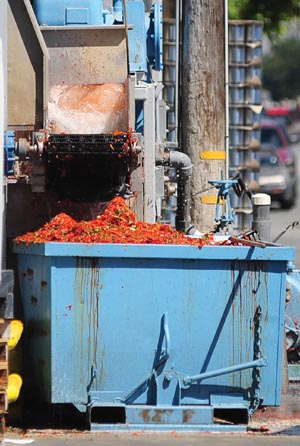A discussion about foul odors caused by rotting tomatoes became a debate over water, particularly the massive amounts of it going into the industrial wastewater pond and the use of the resource to clean the sewage system.
Hollister council members heard a presentation Monday about the odor caused by the San Benito Foods tomato cannery and its waste treated at the industrial sewer pond, one of two wastewater ponds in Hollister. The foul smell largely affected the west side and downtown for several days at the end of July and in early August – caused by excessively low pH levels – but a contracted sewer plant operator told council members it was under control as of Monday.
During his presentation, though, Manny Molina with Veolia Water talked about the annual San Benito Foods schedule for the industrial pond – its only purpose is treating cannery waste – which involves a sudden flow of sewage each July when summer canning season starts.
Molina pointed out that flows start at about 200,000 gallons daily and build up to 2.5 million gallons daily for the 10- to 12-week canning season. That is more than the 2.2 million gallons of waste treated daily at the domestic pond, which serves the entire city outside of the cannery, he said.
“They effectively outproduce all the citizens on a day-to-day basis,” he said.
He also mentioned that it takes more than 17 million gallons to fill the industrial pond.
Molina brought up those numbers in offering context about the impact from the sudden change of pace each year – while offering a set of solutions to address the odor problems that seem to crop up every few years or so.
In responding to the smell issue, the contractor said San Benito Foods was responsive to the problem and reacted immediately, adding massive amounts of water to the system to help flush it out.
While Veolia, the city and San Benito Foods vowed to take several short-term steps to prevent odors, they also plan to take long-term actions. Molina said one option is to take another look at the details in the city and San Benito Foods’ agreement.
“It’s time to go back and reevaluate that permit,” Molina said.
Other ideas he broached included more frequent flushing of the system throughout the year, to consider using recycled water in the cleaning processes and using drying beds in the piping system.
There is a vicious cycle involved, though. Officials have blamed drought conditions for contributing to the odor issue – a total of 33 million gallons in the ponds dried out before this year – while massive amounts of water are used by the cannery.
Councilman Ray Friend was especially concerned about the use of so much water.
“It just seems to me this is not the time to be wasting water,” Friend said.
Mayor Ignacio Velazquez, who was centrally involved in addressing the smell, underscored the cannery’s importance to the local community and said the city would look into options for “diverting” some of the water headed to the ponds.
“We won’t get rid of the smell entirely – it is a cannery processing tomatoes,” he said. “But we should never have to go through what the citizens had to go through on that side of town.”










